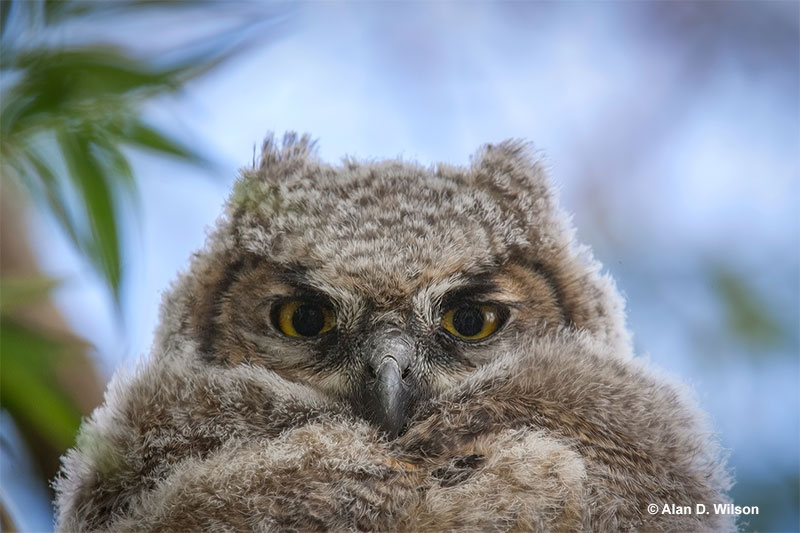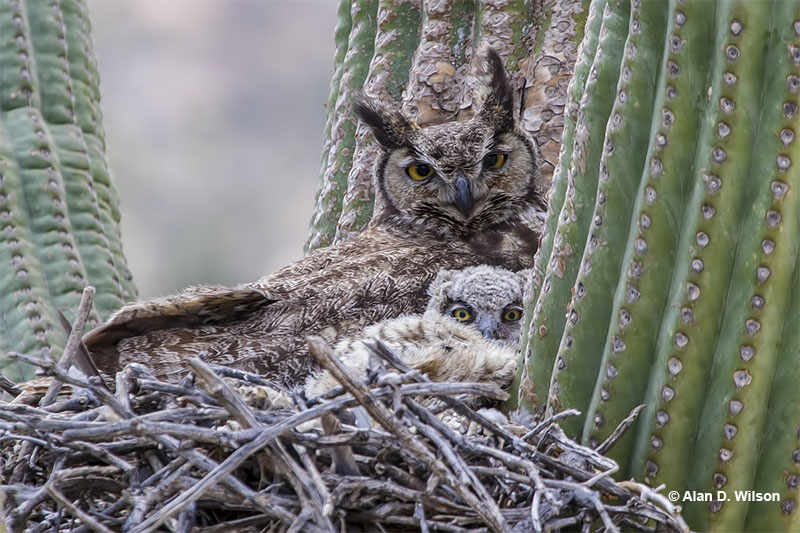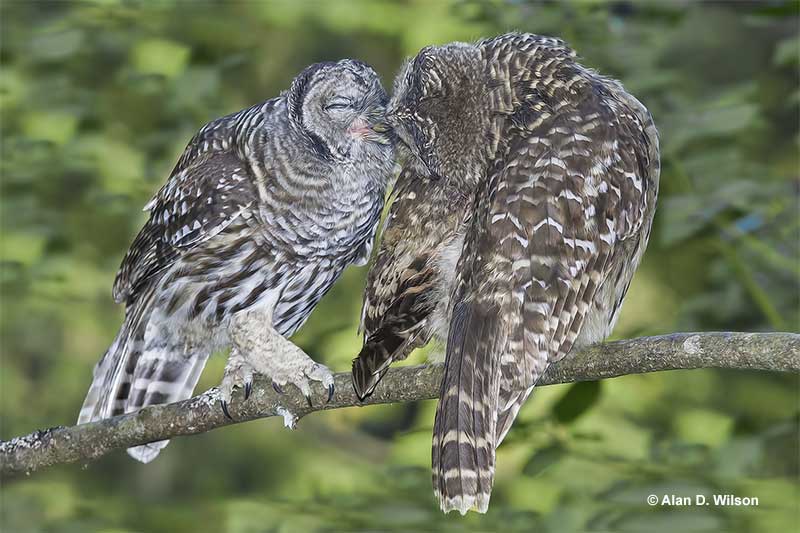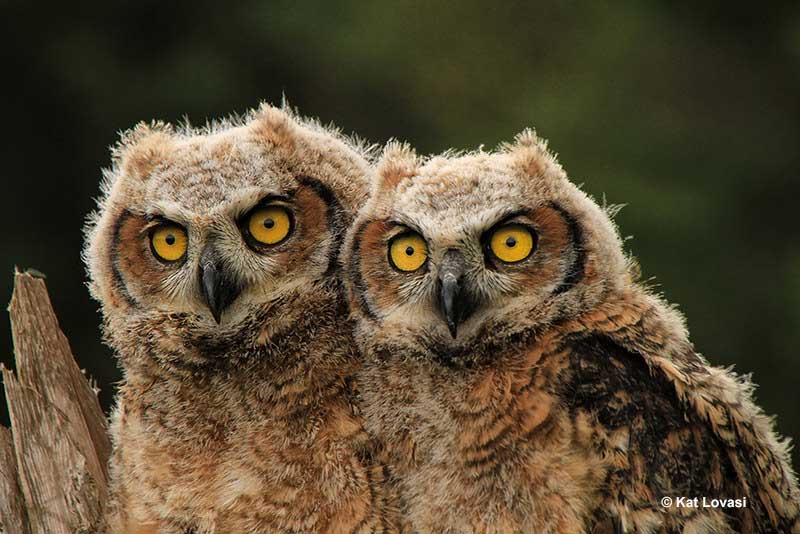
Baby owls are likely the most adorable chicks in the bird world. Endowed in a coat of fluffy downy feathers, with huge round eyes and curious disposition, they look undeniably cute and baby-like. To further enhance the cuteness factor, the sibling owlets always are huddled together, looking like a single assembly of fluff and eyes.
However, despite their superficial cuteness, baby owls are genetically coded to become fierce nocturnal avian predators – precise, silent killers of the night. If you’ve ever observed them practicing their adult feeding skills on the prey provided by parents, you’ll quickly realize what I’m talking about.
What makes baby owls so special? Let’s explore!
On this page
The Beginning – Owl Nests
Like other young birds, all baby owls start out their lives in a nest.
You may be surprised that owls, so intelligent and advanced in their hunting skills, aren’t much of a builders. In fact, they very rarely build their own nests. They rather use the old abandoned nests of other birds that suit their size. For example, Great Horned Owl (one of the largest owls in the U.S.) uses nests in trees or on cliffs built by hawks or corvids.

Great Horned Owl’s nest
Many owls, such as Tawny Owls, Eastern Screech Owls, and Western Screech Owls, nest in the existing tree holes. Some owl species use tree-hole nests previously created by woodpeckers. Famously, Elf Owls (one of the smallest owls) nest in Saguaro cacti holes created by woodpeckers, but also in woodpecker openings in other vegetation and man-made poles.
Burrowing Owls prefer burrows and are known to sometimes nest in abandoned burrows of prairie dogs.
Next come the eggs. Depending on the species and prey availability, owls lay 1-14 eggs. Interestingly, female owl lays the eggs over several days, meaning chicks in the nest are of a different age – there are older and younger owlet siblings.
The usual “labor division” in the owl parent realm is that the female owl incubates the eggs while the male hunts and feeds her. Also, the owl pair is fiercely protective of their brood. The Snowy Owls (Bubo scandiacus) are known to defend the nest and attack potential intruders within a one-kilometer (0.6 mile) radius!
After about a month-long incubation, the owl eggs hatch. Finally, we meet the owlets.
Related: What to do if you find a baby bird
Owls are altricial birds, meaning their young hatch blind, helpless, looking nothing like adults. The pace of their development varies, with smaller species often fledging faster than the large ones. For example, the Short-Eared Owl chicks leave the nest at only two weeks old and can fly in about 4-5 weeks.
On the other hand (or claw), young Great Horned Owls and young Barn Owls stay near the nest for six weeks and start flying in the 7th or 8th week of their lives. However, even after leaving the nest, the parents continue caring for and feeding the juvenile owls for additional few weeks until they can fend for themselves.
What Does A Baby Owl Look Like?
From hatching to fledging, baby owls go through quite a drastic physical transformation. Like in other birds, there is an obvious difference between the hatchlings, the nestlings, and the fledglings.
Hatchling owlets
It may shock you that soft, rounded, and wide-eyed owlets look very different right after hatchling.
The hatchling owl’s downy feathers are short and scarce, revealing the disproportionately large legs and bills. Their eyes are closed, making the chicks effectively blind for the time being. At this point, they are completely helpless and unsteadily wobble around, nodding their big heads, simply waiting for the parents to feed them and warm them.
Nestling owlets
As they mature, owlets take their typical owlet look.
At two weeks old, the eyes are wide open, and their fluff is thicker and longer, making their appearance much more rounded. They remain dependent on their parents but can now control their movements much better and regularly watch their environment. Importantly, they also start thermoregulating and can warm themselves with less and less help from their parents.
Oh, and did you know that baby owls have the same sleep patterns as baby humans? The research on Barn Owls shows that, at first, owlets have long rapid-eye movement (REM) sleep stages, the same as human babies. In a matching pattern, the REM stage shortens as chicks mature.
Fledgling owlets
In two to four weeks, the owlets will start to venture out of the nest – interestingly, weeks before they can fly.
In this “adventurous owlet” phase, people often find them and think they need to be rescued. However, parents are usually nearby and continue to feed the chicks, even when wandering around the nest. As they hop around, fledgling owls will start practicing flying.
Fledgling owls are easy to recognize by their fluffy down feathers. It will take time until they get their adult plumage, but fledglings keep becoming more independent.
How To Tell Baby Owls Apart?
Baby owls have a distinct appearance. Some specific features of owls nestlings include:
- Large, round eyes.
- Rounded heads, with faces less flattened than in adults.
- Thick, fluffed-up downy feathers, usually grey or brown with distinct patterns.
- Strong talons.
Due to the specific looks, it is hard to mistake a nestling or fledgling owl chick for anything else in the bird world. However, the hatchings can be mistaken for other raptor species, such as hawks.
Hatchling owls have short, white downy feathers, and their beaks are much more protruding than in nestlings. Thus, they may be confused for similar-looking raptor hatchlings such as baby eagles or hawks. Still, the owlet’s eyes (open or closed) are much larger than in other raptors.
What Do Baby Owls Eat?
Owls are carnivorous predators, or simply said, birds of prey. Consequently, they feed their owlets with pieces of meat, sized suitable to the brood’s age.
The prey consists of small nocturnal mammals such as mice and voles and sometimes lizards, snakes, and smaller birds. Lemmings are a staple of the Snowy Owl‘s diet; the size and the success of owl broods largely depend on the current lemming population size.
Related: What do baby birds eat?
In most cases, the father owl does all the hunting, while the mother owl tears pieces of meat from the prey and feeds the babies. As owlets grow and begin thermoregulating and feeding on their own, the female takes on hunting responsibilities as well.
As the owlets mature, they get bigger and bigger chunks of meat. When they’re several weeks old, the parents provide the whole prey, and the owlets either tear the flesh themselves or swallow the prey whole.

Young Barred Owl in the care of its parent.
The competition for food between the siblings can be intense. Because not all eggs hatch simultaneously, there are always older and stronger and weaker and younger chicks in the brood, leading to unequal food distribution. If the food supplies are scarce, the youngest owlets may even die of starvation.
However, it’s not all about fighting and the survival of the strongest. We now know that owlets negotiate and barter to decide which sibling should get the next meal. Sometimes, the younger owlets even preen their older siblings in exchange for food!
Baby Owl – Frequently Asked Questions
What is the name of a baby owl?
Baby owls are called owlets or simply owl chicks. Both terms are correct to use.
What does a baby owl look like?
Owl chicks are known for their typical big eyes, rounded heads, and faces, as well as thick, fluffed-up downy feathers, usually grey or brown in color. Also, they have well-developed beaks and strong talons.
Like with other altricial birds, baby owls look differently in different stages of development. We see the classic owlet look described above in owl nestlings. On the other hand, owl hatchlings look quite differently – their eyes are closed, their downy are shorter, thinner, and white, their bills and legs are more prominent, and the overall look is lean rather than round.
How long do baby owls stay with their mother?
Compared to many other raptors of similar size, baby owls develop quickly. The time owlets spend with their parents depends on the species, but the average time is about two months. Barn Owls are among the species who stay with their parents longest. It takes about ten weeks for a Barn owlet to get strong enough to be on its own.

